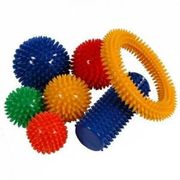Premium Aquatic Therapy & Fitness Gear for Wellness and Recovery
Discover Theraquatics' durable, high-quality aquatic therapy and fitness products designed to enhance rehab, training, and overall wellness. With decades of experience and a wellness-first approach, we provide tools, guidance, and support to help you maximize every water-based session - whether at home, in the clinic, or at the pool.Porcupine Massage Balls
Product Description
These balls have hundreds of sensory nodules. Easy to grip for smaller hands. The long, firm nodules make for perfect massage balls. Great for myofascial therapy. Extremely high quality.
Relaxing, energizing, and stimulating.
Small enough to take with you and use anywhere. Keep one at home, another at work and another in your gym bag. Easy and fun to use on yourself or a partner. Easy to grip in water. Bright colors for visual tracking. Ideal for finger and grip exercises.
Size – you want to select the size based on the body part you’re working.
Hands, forearms or feet – you’ll want to try the green or yellow ball.
Calves, hamstrings, abdomen/psoas, buttocks, upper and lower back, deltoids and neck – the lacrosse ball, tennis ball and baseball sizes work best for these body parts. Their diameters respectively are 63 mm, 67 mm and 73mm.
Chest and shoulders – here you need a blue ball which is an unusual size and most commonly found as a high bounce ball from a toy store.
Options:
Spikey ball, 7cm (2.8in) - GREEN, 8083XS
Spikey ball, 8cm (3.2in) - YELLOW, 8083S
Spikey ball, 9cm (3.6in) - RED, 8083M
Spikey ball, 10cm (4.0in) - BLUE, 8083L
Spikey ball, 15cm (6.0in) - YELLOW, 8083XL
Spikey roll, 6.5x16cm, BLUE, 8083RL
Spikey Ring
Qualities:
Stimulates local vasodilatation to increase blood flow and promote the healing process;
Stimulates the mechanoreceptors to promote the pain gate theory;
Acts as an adjunct for acupressure point release and myo-fascial release;
Promotes endorphin release;
Can assists in scar tissue breakdown.
The spikey ball originated in Denmark to stimulate and arouse psychiatric patients in depressed mental states and associated postural breakdowns. It has been used extensively in Australia and on the European, Asian and US Golf Tours to provide myo-fascial release, self-massage and postural education for tour players. As a result of fixed postures, muscle imbalances and excessive repetition associated with the sport of golf the Spikey ball has been used extensively to alleviate these conditions. This information is now being used for all types of patients with musculoskeletal disorders e.g. computer operators, postural dysfunction in young people and sports injuries to name a few.
Small enough to take with you and use anywhere. Keep one at home, another at work and another in your gym bag. Easy and fun to use on yourself or a partner. Easy to grip in water. Bright colors for visual tracking. Ideal for finger and grip exercises.
Size – you want to select the size based on the body part you’re working.
Hands, forearms or feet – you’ll want to try the green or yellow ball.
Calves, hamstrings, abdomen/psoas, buttocks, upper and lower back, deltoids and neck – the lacrosse ball, tennis ball and baseball sizes work best for these body parts. Their diameters respectively are 63 mm, 67 mm and 73mm.
Chest and shoulders – here you need a blue ball which is an unusual size and most commonly found as a high bounce ball from a toy store.
Options:
Spikey ball, 7cm (2.8in) - GREEN, 8083XS
Spikey ball, 8cm (3.2in) - YELLOW, 8083S
Spikey ball, 9cm (3.6in) - RED, 8083M
Spikey ball, 10cm (4.0in) - BLUE, 8083L
Spikey ball, 15cm (6.0in) - YELLOW, 8083XL
Spikey roll, 6.5x16cm, BLUE, 8083RL
Spikey Ring
Qualities:
Stimulates local vasodilatation to increase blood flow and promote the healing process;
Stimulates the mechanoreceptors to promote the pain gate theory;
Acts as an adjunct for acupressure point release and myo-fascial release;
Promotes endorphin release;
Can assists in scar tissue breakdown.
The spikey ball originated in Denmark to stimulate and arouse psychiatric patients in depressed mental states and associated postural breakdowns. It has been used extensively in Australia and on the European, Asian and US Golf Tours to provide myo-fascial release, self-massage and postural education for tour players. As a result of fixed postures, muscle imbalances and excessive repetition associated with the sport of golf the Spikey ball has been used extensively to alleviate these conditions. This information is now being used for all types of patients with musculoskeletal disorders e.g. computer operators, postural dysfunction in young people and sports injuries to name a few.



